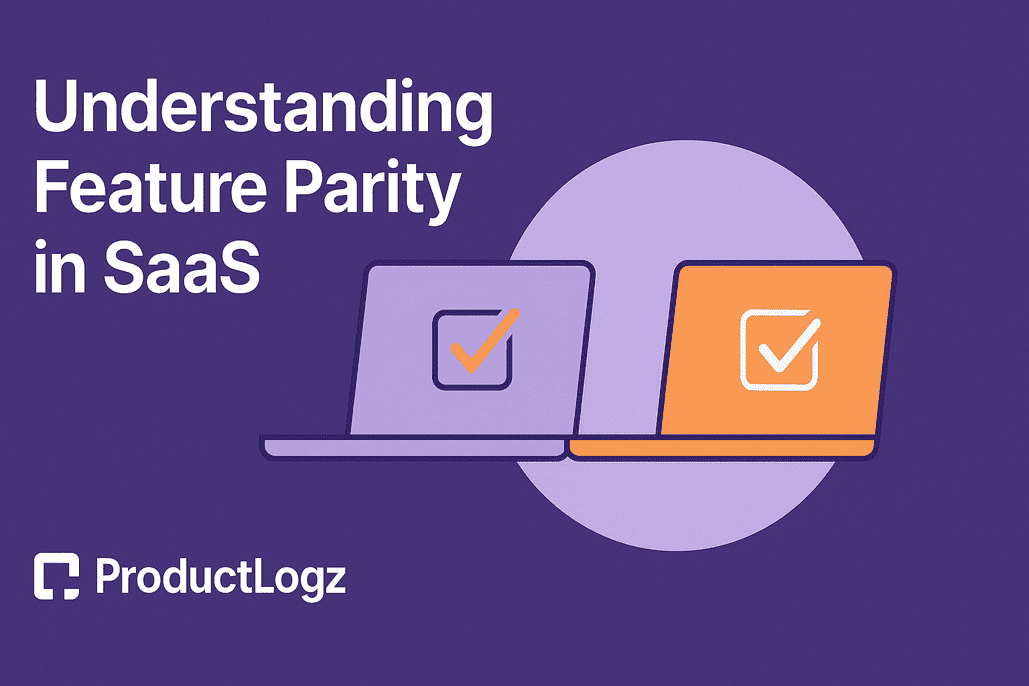
Are you currently building a SaaS product, and you're probably getting slammed with feature requests left and right? Some come from customers, others from sales teams trying to close deals, and a few are probably copied straight from your competitor’s product. In the chaos of product development, it’s tempting to just match everything they have. But that mindset can lead you straight into the feature parity trap. This blog breaks down what feature parity actually means in the SaaS industry, the different types, why it matters, and how to avoid the parity trap.
Feature parity refers to having the same set of features or functionalities across platforms, products, or versions of the same product. For example, if your web app allows users to schedule emails, and your mobile app doesn’t, you don’t have platform parity.
In a SaaS context, feature parity in product means ensuring that customers get a consistent experience across different platforms or versions of your product, whether they use it on desktop, mobile, or even through an API.
However, feature parity is also more than just platforms. It involves maintaining parity with competitors by matching the features and functionalities they offer. This is where things get tricky, and where understanding feature parity becomes essential.
There are a few types of feature parity to be aware of:
This is all about keeping every feature and functionality consistent across every platform within your product ecosystem. If your web app has reporting tools, your mobile app should offer similar features that serve the same purpose.
Here, it involves matching your competitor’s product in terms of features. If a competitor adds a new feature, your team may feel pressure to add it too. While this can help you stay relevant, it also risks turning your product into a clone.
Sometimes you release a new version of your app with fancy upgrades. But your legacy users might still be on the old one. Achieving parity across those versions of the same product ensures users don’t feel left out or confused.
Although feature parity is important, it's not about copying every feature under the sun. It’s more of making sure users can use your product seamlessly, no matter how or where they access it. Here are our other reasons why feature parity in SaaS matters:
Here’s how feature parity plays out in the wild:

Slack maintains feature parity across different platforms. Whether you're using their desktop app, web version, or mobile app, core features like messaging, file sharing, and channel management work consistently. Users can switch between devices without losing functionality. Now, that's a strong internal feature parity in action.

Spotify demonstrates how platform parity enhances user experience. Your playlists, music library, and playback features across all platforms stay synchronized. The specific feature set remains consistent whether you're on your phone, computer, or smart speaker.

For years, Microsoft Word dominated. Then Google Docs caught up by gradually achieving feature parity, and added unique characteristics like real-time collaboration to differentiate its product. The editing tools, sharing options, and collaboration features and functionalities work similarly on mobile or desktop. Meanwhile, these examples show that feature parity ensures consistency, but also that you don’t have to stop there. In fact, you shouldn’t.
The feature parity trap happens when you’re blindly copying features just to match competitors. You think, “They added it, so we need it too,” without asking, “Does this align with our product strategy or user needs?”
It’s a situation that's quite easy to fall into. Your sales team wants a specific feature to close a deal. A loud customer insists on it. A competitor launches something flashy. You react, rather than plan. And soon, you’ve built a bloated product full of unnecessary features that confuse users and slow you down.
Actually, this is where feature creep and feature bloat begin. Unfortunately, it pulls your product team away from improving core features or delivering the features that deliver real value.
You’re not just here to achieve feature parity. You want to build the best product, not just the most crowded one. So, here’s how to avoid the feature parity trap:
You need to use customer feedback and user feedback strategically. Listen to what real users actually need, not just the loudest voices demanding specific feature additions. Tools like Productlogz help product teams collect, organize, and act on feedback from real users, ensuring you focus on features that deliver value, not just noise.
Every aspect of product development should tie back to your product roadmap and long-term goals. Before adding a feature, ask: Does it align with your product vision?
Don’t just chase parity, learn to innovate. Focus on what makes your product unique. Then, build features to meet user needs in ways your competitors haven’t thought of.
Understand the competitive landscape before reacting. Is that new feature a game-changer or just noise? Market research helps you stay grounded.
You can’t build everything. Prioritizing features is essential. Ask your product managers to stack rank feature ideas based on impact, feasibility, and alignment.
Sometimes, fewer features make for a better experience. Keep the focus on making every platform support the essentials before branching out. Also, remember to track your feature development cycle closely. If you’re constantly scrambling to keep up with competitors, it’s time to revisit your product management process.
Feature parity is essential, but it’s not the goal. It’s a tool to ensure your product feels cohesive and delivers value. But if you’re not careful, parity becomes a trap, pulling your team into endless cycles of adding features just to keep up. To build a truly great product, focus on solving real problems. Keep your product aligned with your vision. And always build for the people who actually use your product.
Start collecting meaningful feedback without any set-up hassles